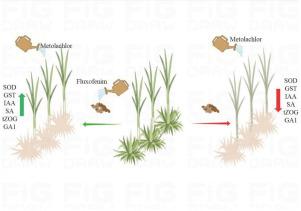Pesticide Biochemistry and Physiology ( IF 4.2 ) Pub Date : 2023-11-14 , DOI: 10.1016/j.pestbp.2023.105692 Yannan Shi 1 , Jinping Wang 1 , Zhifang Wang 1 , Zhiyin Jiao 1 , Qi Du 1 , Xinyue Jia 1 , Jingtian Niu 1 , Ruiheng Du 1 , Guisu Ji 1 , Pengwei Duan 2 , Peng Lv 1 , Junfeng Cao 3

|
The extensive use of herbicides has raised concerns about crop damage, necessitating the development of effective herbicide safeners. Fluxofenim has emerged as a promising herbicide safener; however, it's underlying mechanism remains unclear. Here, we screened two inbred lines 407B and HYZ to investigate the detoxication of fluxofenim in mitigating metolachlor damage in sorghum. Metolachlor inhibited seedling growth in both 407B and HYZ, while, fluxofenim could significantly restore the growth of 407B, but not effectively complement the growth of HYZ. Fluxofenim significantly increased the activities of glutathione-S-transferase (GST) to decrease metolachlor residue in 407B, but not in HYZ. This implys that fluxofenim may reduce metolachlor toxicity by regulating its metabolism. Furthermore, metolachlor suppressed AUX-related and JA-related genes expression, while up-regulated the expression of SA-related genes. Fluxofenim also restored the expression of AUX-related and JA-related genes inhibited by metolachlor and further increased expression of SA-related genes. Moreover, we noted a significant increase in the content of trans-zeatin O-glucoside (tZOG) and Gibberellin1 (GA1) after the fluxofenim treatment. In conclusion, fluxofenim may reduce the injury of herbicide by affecting herbicide metabolism and regulating hormone signaling pathway.
中文翻译:

整合转录组和生理分析来阐明高粱对fluxofenim和异丙甲草胺除草剂的分子反应
除草剂的广泛使用引起了人们对作物损害的担忧,因此有必要开发有效的除草剂安全剂。 Fluxofenim 已成为一种有前途的除草剂安全剂;然而,其根本机制仍不清楚。在这里,我们筛选了两个自交系407B 和 HYZ,以研究 Fluxofenim 在减轻高粱中异丙甲草胺损害方面的解毒作用。异丙甲草胺均抑制407B和HYZ幼苗的生长,而氟芬宁可以显着恢复407B的生长,但不能有效补充HYZ的生长。 Fluxofenim 显着增加谷胱甘肽-S-转移酶 (GST) 的活性,从而减少 407B 中的异丙甲草胺残留,但在 HYZ 中则不然。这意味着fluxofenim可以通过调节其代谢来降低异丙甲草胺的毒性。此外,异丙甲草胺抑制AUX相关和JA相关基因的表达,同时上调SA相关基因的表达。 Fluxofenim还恢复了异丙甲草胺抑制的AUX相关和JA相关基因的表达,并进一步增加了SA相关基因的表达。此外,我们注意到fluxofenim处理后反式玉米素O-葡萄糖苷(tZOG)和赤霉素1(GA1)的含量显着增加。综上所述,fluxofenim可能通过影响除草剂代谢、调节激素信号通路来减轻除草剂的药害。































 京公网安备 11010802027423号
京公网安备 11010802027423号